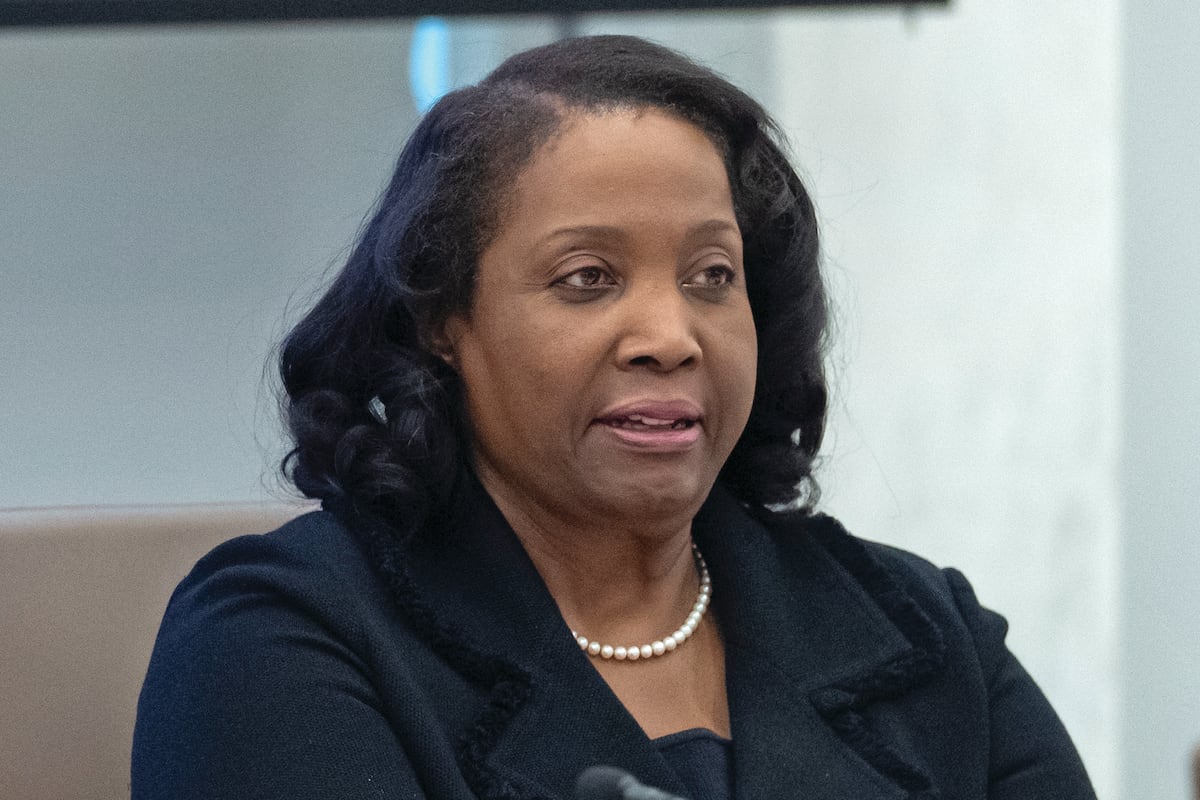
The core constitutional claim behind President Donald Trump’s effort to oust Lisa Cook from the Federal Reserve Board of Governors is the same claim he makes to justify nearly all of his attempts to seize power: that Article II, Section 1 of the Constitution — “The executive power shall be vested in a president of the United States of America” — grants him unlimited authority over the entire executive branch and everything it touches.
Specifically, to paraphrase Trump and his allies, it gives him the inherent authority to remove any official working in the executive branch, under the theory that anyone exercising any part of the executive power must necessarily serve at the pleasure of the president.
But there are many reasons to think that, as Chief Justice William Rehnquist wrote in 1988 in a footnote to his opinion in Morrison v. Olson, this reading of “general constitutional language” is far “more than the text will bear.” And beyond the text, it is a direct repudiation of the larger idea of deliberative self-government.
First, let’s consider a few of the factors that complicate the president’s claims to virtually unlimited executive authority. There is the structure of the Constitution, which gives considerable authority to Congress to shape the executive branch and carefully enumerates the powers of the president. There is the logic of American-style constitutional government, whose aim is to concentrate power only as much as is necessary to preserve self-government and achieve a “more perfect union.”
And then there is the actual practice of government, stretching back to the First Congress. When given the opportunity to establish a strong presidential removal power in what is called the Decision of 1789, Congress said no. “A clear majority rejected this position, and an even more substantial majority opposed the indefeasibility of those powers,” the legal scholar Jed H. Shugerman observes in a 2023 paper on the subject.
But while all of this is interesting (to me at least), there’s almost no point in parsing the history because the president’s claim is as political as it is constitutional. In the view of the White House, it’s not just that Trump is vested with inherent authority to remove whoever he wants from office, but also that as one of two officials elected by the nation at large — and the top person on the ticket — the president is also imbued with the will of the people. This gives him the sovereign authority to do as he pleases, so that he might fulfill that will. It is the responsibility of every agency, under this view of executive power, to “advance the president’s priorities,” even if those priorities conflict with the law.
In this, the administration is echoing a line from the Supreme Court’s majority opinion in Seila Law v. Consumer Financial Protection Bureau, decided in 2020, in which Chief Justice John Roberts wrote that “the framers made the president the most democratic and politically accountable official in government” because “only the president (along with the vice president) is elected by the entire nation.” For Roberts and the majority, this purported fact meant that the director of the Consumer Financial Protection Bureau could not, constitutionally, be insulated from direct presidential control.
Neither Roberts nor any of the supposedly originalist members of the court seem to either know or care that the presidency, as envisioned by the framers, was meant to be insulated from direct popular influence, not an expression of it. The Electoral College was a single-use legislature designed to stymie factional feeling, and electors were to be chosen by each state legislature. The president was more politically accountable than a justice of the Supreme Court (with lifetime tenure) or a member of the Senate (serving six-year terms and originally appointed by their state’s legislature as well) but far less accountable than a member of the House of Representatives, which was designed to be the most politically accountable institution in the federal government, with two-year terms for each member.
But as is often true when this Supreme Court is set on a certain political outcome, it does not worry itself so much with what the history actually says. In any case, the position of the Trump administration reflects both the body of unitary executive precedent established by the court and the president’s pretense to autocratic power. By dint of inherent executive authority and the sovereign power given to him by the American people in a democratic election, according to this way of thinking, Trump has an unlimited right to remove whomever he pleases from the executive branch, with or without congressional approval. This, we’re told, is supposed to be a form of democratic accountability vis-à-vis independent agencies and distant federal bureaucrats.
Or, as the heterodox conservative writer Sohrab Ahmari put it in relation to the president’s attempt to fire Cook, “At issue, now as then, is whether the shape and management of U.S. currency and the money supply should be subject to democratic contestation — or left to the supposedly ‘neutral’ determination of expert bankers.”
There is something odd, however, about a democratic accountability that relies on maximalist claims of executive power and the subversion of congressional statutes. It seems positively strange, in fact, to have to point out that Congress — a coequal branch of government with more power at its disposal than any of the others — is democratically elected. But it’s true. Majorities of Congress are, in fact, democratically elected alongside the president. And where the public has one chance only every four years to choose a president, it has one chance every two years to choose a Congress.
There is also the seemingly forgotten fact that the executive departments are creatures of Congress. That is why the president’s order to rename the Department of Defense the Department of War is merely cosmetic — by statute, it is still the Department of Defense, no matter what the new logo says.
In truth, neither Congress nor the executive can claim to represent the undivided will of the American people. It is arguable whether such a thing even exists in the American system, as the public is not a single entity but an ever-shifting set of groups and interests. Congress represents the American people in their diverse and fractious unity, and the president represents a will of some of the people, briefly assembled for a fleeting purpose, to dissipate until it forms anew in the next election.
It is simply a conceptual error to think of democratic legitimacy as a grant embedded in a single person. It’s better to see it as a relationship between our political institutions and the publics they serve, each responsive to the other as they work together to do the business of government.
Independent agencies like the Consumer Financial Protection Bureau and the Federal Reserve exist at the nexus of congressional authority, presidential influence and public responsibility. They are made to be democratically accountable through their obligations to each. No, these agencies cannot be grasped by the president and manipulated for his own purposes, but that is how it should be; the president is an officer of the Constitution, not a sovereign avatar of the people. His control, on its own, does not equal democratic accountability.
But then the great claim of Trump and his allies is that he very much is the sovereign avatar of the people. And it’s a position that runs against the whole concept of American constitutional government, which seeks to limit the exercise of power.
Consider what it would mean to have a sovereign president. He would not need a legislature to make war or raise funds. He could not be bound by law because he is the law. A sovereign president is, for all intents and purposes, a king. And the simple fact is that the American Constitution does not create, or permit, a king.
Here, let’s bring this back to the Federal Reserve.
Late in the summer of 1913, Rep. Carter Glass of Virginia introduced the bill that would become the Federal Reserve Act. His colleagues, the duly elected members of the House and the Senate, debated and eventually passed that bill. The elected president, Woodrow Wilson, signed it into law.
On the House floor, speaking in support of the bill, Glass said that the Federal Reserve Board would be “a part of government itself, representing the American people, with such powers as no man would dare misuse.” Rep. Charles Robert Crisp of Georgia, another supporter, also defended the Fed as a democratic institution. “Under the present law a few great banks control the money of our country, and thus dominate and control business, while under this Democratic bill they are shorn of this great power and the finances are under the control of the Federal Reserve Board appointed by the president of the United States, who will be the representatives of the American people, who will have the interest of all the people at heart and not be influenced by selfish and mercenary motives,” he said.
It was all straightforward. The Federal Reserve would be imbued with the democratic legitimacy of an institution birthed by Congress and designed to serve the American people. Its board would be further imbued with the democratic legitimacy that comes with both presidential appointment and statutory independence. So while insulated from the quotidian pressures of everyday political life, the Federal Reserve would still be accountable to the national legislature, which could change and amend its charter as necessary.
The Federal Reserve, in other words, already is democratically accountable. It is not necessary, for that accountability, to grant the president an unlimited removal power. Just the opposite: At-will removal takes what was a collective, democratic decision and places it in the hands of one man. It subverts the design of a government built to rely on consensus among branches as much as conflict among them to make policy.
The Madisonian system is not one of a singular president running roughshod over a host of subordinate constitutional actors, but of a set of equals working together to fulfill the many wills of the American people. The task of democratic self-government is to align those often-conflicting (and always changing) wills as much as possible in pursuit of a common interest. The alternative, that of the sovereign president, owes more to 20th-century apologetics for European despotism than it does to anything in the American political tradition.
The fight over the fate of Cook is so much more than a narrow question of personnel. It gets to the very foundations of the American political order. Trump and his allies are not just making a claim of overweening presidential authority; they are making a bid to transform American government itself. This is one very revealing example of how they are trying to redefine the 2024 presidential election away from what it was — a democratic choice subject to revision and the authority of other democratic forces — into something wholly new, an enabling act for presidential dictatorship. And in this, they have allies in American society, on the courts and in Congress.
But the American people, throughout their history, have been jealous of their liberties, to the point of taking real action to preserve them. We shall hope that as Trump attempts his autocratic transformation of our government, they will hold on to that protective vigilance.



